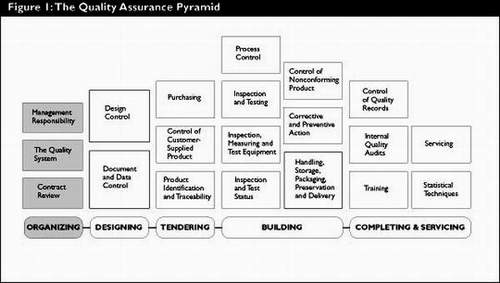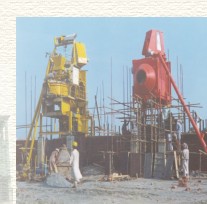Quality Program
GUARANTEE ENGINEERS is manage by a group of professional engineers and is always striving to achieve high quality standards in accordance with international engineering code requirements.
Basic details of our Internal Quality Program are as follow:
Quality Policy
Meet and exceed specified engineering standards, complete within allotted time, comply with safety requirements and satisfy customer's needs.
Quality Control Plan
Our Quality Control Manual consists of five basic chapters, each of which incorporates the basic requirements of the ISO 9000 standard:
-
Chapter 1: Organizing for Quality
-
Chapter 2: Designing for Quality
-
Chapter 3: Buying Quality
-
Chapter 4: Building Quality
-
Chapter 5: Completing and Servicing Quality.
Together they comprise the Quality Assurance Pyramid shown on the next page, which is the organizing framework for our manual.

Chapter 1: Organizing for Quality
Chapter 1 provides general guidance on establishing, maintaining and monitoring a Quality System. These guidelines cover establishing a company-wide quality policy, appointing Quality Management Representatives (QMRs), defining responsibility for quality on a project-by- project basis and reviewing the quality system.
The Company Quality Plan defines the organization’s approach to quality assurance, while Project Quality Plans refine the general approach for each new project.
The Contract Review procedures are also part of this chapter. The Contract Review verifies procedures such as identifying the customer’s needs and the ability of the company to provide the required services on time. It ensures details such as durability and maintenance expectations, documents the building performance criteria and notes all amendments to the contract agreements.
Another important element of the Contract Review is the requirement to ensure all elements of the bid satisfy the balance between quality and cost considerations.
Chapter 2: Designing for Quality (If Project Requires)
Chapter 2 defines the two essential components of designing for quality: Building Design Control, and Document and Data Control.
The purpose of Design Control is to ensure that design activities follow documented and maintained procedures in order to meet requirements of the international construction codes, Government laws and client requirements.
The Document and Data Control system establishes guidelines for controlling documents and data essential to the design, construction, assembly, inspection, review and commissioning of a project. These guidelines describe the means and methods of identification, collection, indexing, filing, storage, maintenance, retrieval and disposition of documents and records. They also ensure that any changes to the documents are recorded.
Chapter 3: Buying Quality
Chapter 3 addresses the need to inject quality considerations into the purchasing of materials, systems and services used in the construction of the project. It also identifies methods for assuring and verifying that customer-supplied products and services are in line with contract requirements and the guidelines provided in the Quality Manual. In addition, it suggests procedures for identifying and tracing products and services, both to reduce errors in initial construction and make traceability problems easier. This improves the ability to repair latent defects.
Also provided are guidelines about purchasing procedures, responsibilities, assessing suppliers, purchase order data and other information related to the quality of purchased goods and services.
Chapter 4: Building Quality
Chapter 4 addresses control of the construction process. It contains seven sections: Process Control; Inspection and Testing; Inspection Measuring and Test Equipment; Inspection and Test Status; Control of Non-conforming Product; Corrective and Preventive Action; and Handling, Storage, Packaging, Preservation and Delivery.
Process Control suggests procedures for controlling the operations involved in construction. It applies to all activities that affect the quality of the work.
Inspection and Testing guidelines deal with verifying the quality of the finished product activity, its proper functioning and expected durability. These guidelines cover the following activities:
-
Receiving Inspection for verifying the quality of materials received on-site, including those supplied by the customer.
-
In-process Inspection for assuring the quality of the work performed on-site by builders, suppliers or installers, including mock-up preparation.
-
Final Inspection for reviewing the finished product or a specific stage of the finished product, such as concrete work, electrical framing or cladding.
The next section—Inspection, Measuring and Test Equipment—describes a set of procedures for controlling, calibrating and maintaining inspection, measuring and test equipment. This is the equipment used to verify the conformance of the elements of the building to specified requirements.
Inspection and Test Status details a method for indicating the conformance or non-conformance of a completed project, project activity or related purchased products with regard to inspection and tests performed.
Control of Non-conforming Product outlines a system for identifying, rejecting, reworking or disposing of a project, an element of a project, or purchased material or a service that does not conform to specified requirements. The procedure recommended is the use of a HOLD tag to identify the material and a HOLD tag log for recording pertinent information.
Corrective and Preventative Action describes a procedure for identifying substandard aspects of the project or related purchased products. The guidelines include reporting the problem, recording it in the Corrective Action Request Log, investigating, implementing corrective and preventive action, and confirming that these actions have taken place.
Handling, Storage, Packaging, Preservation and Delivery procedures ensure that products used in the construction of the project are transported, stored, packed, preserved and delivered in a way that protects them against damage or deterioration. These procedures apply to building materials, as well as purchased and customer-supplied components, at various stages of the construction process. As with the other components of the Quality Assurance Pyramid, there should be records such as a Receiving Log and a Building Site Construction Log.
Chapter 5: Completing and Servicing Quality
Completing and Service Quality addresses implementation in five areas to ensure a quality construction process. These areas are Control of Quality Records; Internal Quality Audits; Training; Servicing; and Statistical Techniques.
Control of Quality Records outlines appropriate methods for collecting, storing, retrieving, retaining and disposing of records, which may be in any type of media. These can include inspection records, test data, commissioning reports, design review and verification reports, material certificates, equipment calibration data and other documents.
Internal Quality Audits allow to regularly evaluate the effectiveness of the complete Quality System. In addition, they identify discrepancies, which should be reported to the building envelope provider’s senior management in a timely manner.
Training defines the company’s policy for training the personnel who provide the Labour and services on a building site. It should ensure all employees understand the Quality System, maximize the use available skills, experience and expertise and improve the availability of people with interchangeable skills.
The guidelines recommend assessing training needs, identifying training programs and monitoring results.
Servicing refers to the need (if required by the contract) to establish and maintain documented procedures for performing, verifying and reporting that servicing meets specified requirements. Guidelines in this area include identifying customer needs with respect to servicing, defining these needs in the contract, assigning responsibility, reporting and handling warranty complaints, training service personnel and maintaining service records.
Statistical Techniques help verify the conformance of the building envelope quality to specified requirements. They assist in monitoring project progress, inspection activities, investigating Corrective Action Requests and monitoring quality performance. Simple check sheets, diagrams such as bar and line graphs, and logbooks are recommended for this purpose.
In addition to the five parts of the Quality System, the manual contains appendices with sample forms, review sheets, reports and schedules.




